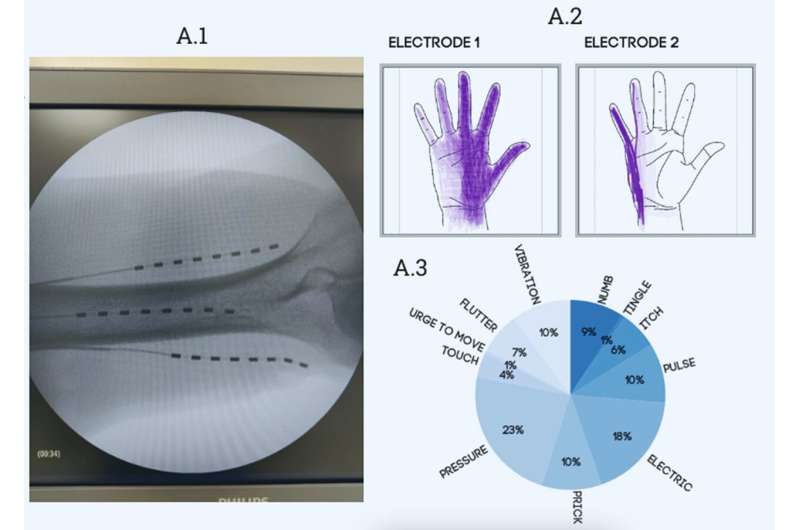This article has been reviewed according to Science X's editorial process and policies. Editors have highlighted the following attributes while ensuring the content's credibility:
fact-checked
trusted source
proofread
Amputees distinguish between objects using prosthetic hand and feel relief from phantom pain: Study

Researchers from Skoltech, the Far Eastern Federal University, and prosthetic hand manufacturer Motorica have reported the results of their latest experiments in sensitization of prosthetics and phantom pain suppression in double hand amputees.
By sensing and interpreting electrical impulses delivered to a nerve in the upper arm region, two patients were able to discriminate between larger and smaller objects using their robotic hands, without looking. They also reported reduced or no phantom pain. As of today, commercial prosthetics lack sensory feedback, and phantom pain—if treated at all—is relieved via electrical stimulation at the spinal cord, which has a number of drawbacks. The study has been published in Brain Stimulation.
"When a spinal cord stimulator is used to relieve phantom pain, this has the side effect of creating a tingling sensation known as paresthesia that is poorly localized and might span the entire phantom arm. The pain itself, on the contrary, might be felt in just two phantom fingers, for example. Our experiments are pioneering the approach that could one day see phantom pain eliminated in a more focused way by stimulating peripheral nerves as opposed to the spinal cord (or the brain)," the first author of the study, Gurgen Soghoyan of Skoltech Neuro, commented.
Compared with spinal cord stimulators, electrodes implanted into a peripheral nerve are also less susceptible to unwanted migration, the scientist said. Over time, this migration causes the stimulation to affect parts of the body other than those the device was originally aimed at.
Finally, peripheral stimulation could simultaneously serve two purposes: Besides suppressing phantom pain, it can provide sensory feedback for the prosthetic hand user to have a "feel" of the objects they are interacting with. This could ultimately be the solution to one of the main problems of prosthetics, as perceived by the patients themselves.
"Unexpectedly, in our experiment both patients scored equally well on the task regardless of whether implanted or surface electrodes were used," Soghoyan said. "Invasive stimulation is more stable and reliable: It creates sensations in the right areas of the phantom limb and is considered better-suited for restoring sensory feedback. Well, apparently, for some patients both approaches could work equally well."
The researcher did acknowledge, however, that a patient poll conducted by the team still indicated higher embodiment scores for invasive stimulation. The notion of embodiment refers to a sense that the prosthetic hand is woven into the body map and perceived as an integral part of the "cyborgized" body.
In another experiment, a participant succeeded in telling the difference between a larger cylinder-shaped object from a smaller one—and from an empty hand—by holding them in 78% of the attempts. He received stimulation from an electrode implanted into the median nerve in the upper arm region. Stimulation intensity depended on the extent to which the fingers of the prosthetic hand have been closed. The type of stimulation was chosen so that the patient perceived it as the clenching of a phantom fist.
The researchers could achieve this match between the observed hand motion and sensation, because they had previously worked with the patient and documented his subjective perception of various kinds of stimulation in a so-called sensory mapping procedure. Before carrying out the test, the subject had a chance to practice by handling the cylinders with his eyes open.
As for the phantom pain suppression experiment, one of the patients said the pain disappeared completely, and the other reported a 40%-70% decrease in pain, varying from day to day over the course of a little more than a week. Invasive stimulation was used.
"The interesting and unexpected thing here is that while the electrodes were implanted into the upper arm only on the right side of the body, one of the patients reported that the pain was no longer felt in both phantom arms. This serves to show yet again: The phantom pain mechanism involves the central nervous system," Soghoyan said.
"The brain of an amputee is known to undergo certain readjustments that encompass the regions responsible for movement and the sense of touch—the motor and the somatosensory cortices. There are, however, only guesses so far as to how this relates to the phantom pain phenomenon."
More information: Gurgen Soghoyan et al, Peripheral nerve stimulation enables somatosensory feedback while suppressing phantom limb pain in transradial amputees, Brain Stimulation (2023). DOI: 10.1016/j.brs.2023.04.017




















